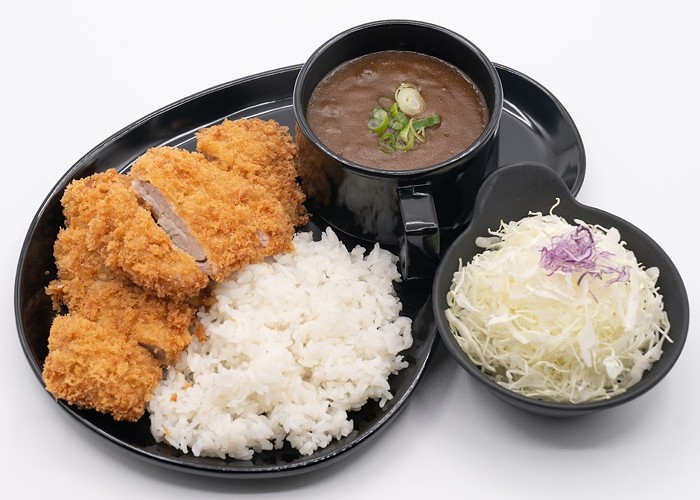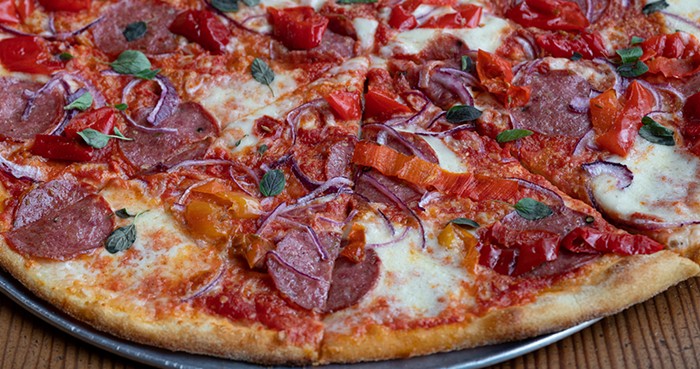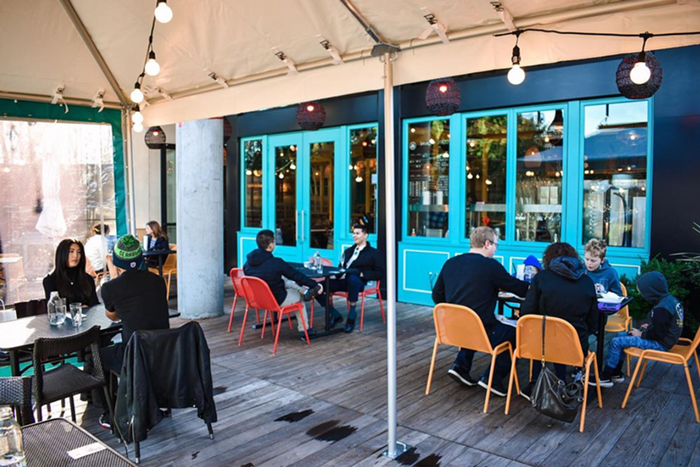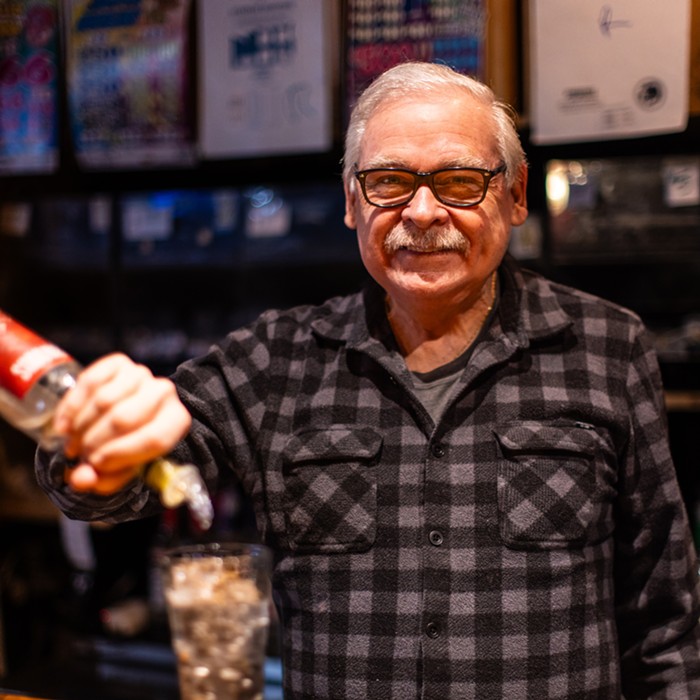The Italian food I am talking about, however, has probably very little to do with Italy. What I'm referring to should be properly labeled Italian American food--i.e., spaghetti 'n' meatballs, lasagna, chicken parmigiana... anything heavily slathered in red sauce, garlic, salty mozzarella. I'm sure the difference between Calabrian and Sicilian cooking is fascinating, but my heart belongs to Brooklyn, Staten Island, and Arthur Avenue in the Bronx.
Italian American cuisine is what happened when first-generation Italian immigrants met American ingredients (and American portions). These cobbled-together ingredients and sensibilities became legitimate dishes in their own right, and ethno-culinary rules continue to stretch and blur: You can find pan-Asian pizzas in any major U.S. city; once-exclusive Italian gourmet items like buffalo mozzarella and canned San Marzano tomatoes can now be easily found at most specialty food shops; and even the Moroccan-owned Bella Rosa Bistro in Ravenna throws preserved lemons in all sorts of Italian entrées.
I've covered this territory before ["Wallowing in un Fiume di Crema," Chow, Jan 17, 2002]. But these days, with the release of the Sopranos Family Cookbook (Warner Books) and recent success of The Babbo Cookbook (Clarkson N. Potter), Mario Batali's bestseller about specific, innovative, regionally inspired Italian cooking, the epicurean debate about what constitutes "authentic Italian" vs. Italian American has been especially heavy in the NPR/Food Network ether.
I am not, however, interested in this debate. I just want some baked ziti. I want a lot of cheese--literally and figuratively. I want a loud, tacky Italian restaurant where the marinara is made fresh every morning, "That's Amore" is blaring on the speakers, and framed photos of Sinatra and circa-1958 Sophia Loren (with her ample bosoms) hang on the walls. Last week, I randomly chose a few neighborhood restaurants in search of red sauce and ravioli. The results emphasized the significance of this ever-evolving, unabashedly emotional cuisine.
Simpatico 4430 Wallingford Ave N, 632-1000.
The cheese factor: Quite low, actually. With soothing jazz on the stereo, a pastel mural on the wall, and dim cocktail lamps at tables, Simpatico's tasteful, elegant décor is more Greenwich, Connecticut, than Bay Ridge, Brooklyn. But while the cheese in the ambience is kept to a minimum, you'll find Romano, Asiago, or mozzarella liberally used in pizzas, pasta dishes, and the vegetarian-friendly eggplant napolean ($14.95).
Why it's Italian American: You can add grilled chicken breast ($3.50 extra) or grilled shrimp ($5.50 extra) to any salad on the menu. Stuffed grape leaves ($7.95) ring loudly of American-eclectic ambition--perhaps too much ambition: Fragrant leaves envelope risotto, pork sausage, pine nuts, and currants, all doused with a pomegranate molasses (overwhelmingly sweet and tart, in my opinion). Entrées are served with a comforting side of mashed potatoes and the vegetable of the day.
And the food? The night I was there, my pork medallions were decidedly overcooked, in a puddle of overpowering Marsala sauce. But the accompanying mashed potatoes were amazing--so loaded with sweet cream butter, so right on, whipped to fluffiness with roasted garlic; and the green beans were expertly sautéed with more garlic and slivers of roasted red peppers. Linguini Della Casa ($12.95) boasts enormous housemade meatballs, tight and beefy with minimal interior seasoning, swimming in a familiar red sea. (Simpatico's marinara is more sugary than most, recalling the buffets and noisy restaurants from my spaghetti childhood.) The fresh mozzarella--prominent in the caprese classico ($7.95) and bruschetta pomodora ($6.95)--is dreamy: clean and subtle, with perfect, velvety texture. I liked it best on the antipasti plate ($8.95), where it was left alone in all its milky, naked glory (not even salt and pepper, a great palate neutralizer) next to savory Toscano salami, smoky peppers, superbly marinated mushrooms, meaty olives, and other favorites.
Perchè No 621 1/2 Queen Anne Ave N, 298-0230.
The cheese factor: Fuhgeddaboutit. Perchè No would fit right in on Mulberry Street, with its deliberate cozy clutter and classic details--a bottle of house red and San Pellegrino on every table, fake flowers, meticulously folded napkins, waiters in bow ties, low lighting. These days adorably gaudy holiday decorations are everywhere, Christmas lights twinkle, and the piano player/singer duo (yep, right there in the dining room) run through seasonal standards. Look around and you half expect to see Joeys, Frankies, and Carmines rubbing elbows over veal scaloppine at corner tables. The only thing missing is Benny the Bruiser watching the car out front while you're having dinner.
Why it's Italian American: It's that whole melting-pot thing. Husband-and-wife team David and Lily Kong--that's right, Kong--own the joint. Perhaps this explains why the place is called Perchè No (translation: "Why not?"). David runs the kitchen, with more Asian cooks than you'd normally expect to be handling your gnocchi, while Lily manages the front of the house with warmth and class.
And the food? You'll find hearty treats like veal porterhouse ($30.50) or wild boar sausage ($16.50) alongside an impressive selection of various fresh seafood and pasta dishes you couldn't necessarily duplicate at home (next time I'm getting the handmade gnocchi with porcini mushrooms and white truffle oil, or the homemade squid-ink linguine). I did, however, try the lovely and blissfully simple beef ravioli ($11.95) in tomato-cream veal sauce, and I was also pleased with the tender sea scallops ($21.95), brightened with tomatoes, capers, and lemon juice. The antipasti selection ($10/person) changes according to Chef Kong's whim, but make sure you request the calamari salad, marinated portobello, and buffalo mozzarella stacked with tomato and aromatic basil.
Luigi's Grotto 102 Cherry St, 343-9517.
The cheese factor: The windowless, subterranean rooms--exposed brick, candlelight, distressed cement floors--give this place plenty of Mob-hideaway/social-club appeal, and there's no shortage of endearing kitsch and knickknacks... sort of Shabby Chic meets Goodfellas. Luigi (who also owns pasta joint Cafe Bengodi next door) works the room himself with relentless energy: greeting you loudly, reciting the menu, directing waiter-busser traffic, hovering affectionately over tables. (Did I mention hovering affectionately? For a minute there, I thought I was in Hugh Hefner's grotto.)
Why it's Italian American: Look up and you'll spot a Stewart Street sign above the door, a universal Italian-American-pizzeria-family-restaurant symbol. Instead of conventional table bread, you get a basket of pita (!) and a crock of mild, smooth hummus (!!) when you're first seated. Perchè no? Somehow it just makes sense. Espresso-soaked tiramisu ($6) is squirted with lots of Hershey's syrup--a move that would probably give Mario Batali a stroke, but I'm not complaining.
And the food? My shellfish appetizer ($12) was a pleasant curveball, a smart example of how Italian American food can be reinterpreted. I expected the typical steamy bath of bivalves percolating in garlicky broth, maybe a couple of lemon wedges and a hint of white wine. Instead I got seared--and I mean super-hot-SEARED, almost like they had a quick roll in a sizzling wok--mussels and clams, smeared with a delicious paste of garlic, parsley, and cracked pepper (and was that spinach purée I tasted?). There was no wimpy liquid to speak of--just intense, concentrated flavors and plump, juicy shellfish slicked with robust olive oil. According to my dining companion, who always kindly volunteers to try shrimp dishes since I cannot (I'm extremely allergic), the penne with spinach and a generous serving of prawns ($17) was also good, anchored by a sturdy marinara. But my advice? Splurge on the lamb chops ($20)--broiled with a port-balsamic reduction sauce and finished off with a spread of pungent Gorgonzola. Sautéed greens and a buttery wedge of polenta provide soothing balance for the slightly gamy meat and rich cheese.


















